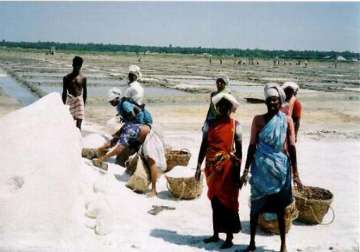Surajbari (Guj), Jan 28: Throughout their lives, members of the Agariya community work tirelessly in the fields of the Rann of Kutch, where they “grow” salt, taking care of almost 75 per cent of the country's demand.
But fulfilling India's salt needs comes at a price, as the salt pan workers face problems like abnormally thin legs which become so stiff that even after death, they do not burn in the funeral pyre.
Their legs are then collected by their relatives and buried separately in a small grave with salt so that they can decompose naturally, workers at the salt pans here said.
Situated around 235 km from Ahmedabad and 150 km from the district headquarters of Kutch, Surajbari creek is at the edge of Little Rann of Kutch and just 10 km from the Arabian Sea.
“Members of the community have been living here for centuries, knowing just one means of living, salt producing.
The ground water here is ten times saltier than sea water, which is pumped out using bores and then filled into small fields of about 25 by 25 meters,” said Mohammad Farukh Pathan, Tourism Officer of Gujarat.
“As the sun beats down on this water, it gradually turns into silvery salt,” he said.
“The Agariyas harvest 10-15 tonnes of salt from each of these fields every 15 days which is then sent to salt companies and chemical factories across the country through trucks and trains. Every family takes care of around 30 to 60 such fields,” Pathan said.
But despite working hard in harsh climatic conditions with day temperatures rising to 40 degrees and nights witnessing 5 degree Celsius temperature, the Agariyas earn a meagre Rs 60 per ton.
One of the poorest communities of India, Agariyas get their skin burnt due to continuous exposure to highly saturated salt and their children rarely go to school.
During the four months of monsoon, when Surajbari creek gets submerged, they are often left without work.
Latest India News
